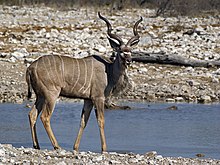Forest bucks
The division of living beings into systematics is a continuous subject of research. Different systematic classifications exist side by side and one after the other. The taxon treated here has become obsolete due to new research or is not part of the group systematics presented in the German-language Wikipedia.
More than two dozen species of antelopes are grouped as forest bucks in seven genera and two tribes, of which two species live in Asia and the rest in Africa. The largest species rich in the cattle approach, and indeed the forest blocks are closely related with the cattle and be with them in the subfamily Bovinae summarized.
The name “forest goats” is not particularly precise, because by no means do all species live in forests. The systematics within this group is also controversial, originally they were summarized as a subfamily Tragelaphinae, according to more recent studies, the wood buck is not a natural ( monophyletic ) group.
Systematics
The following genera and species are counted among the forest bucks:
- Tribus Boselaphini Knottnerus-Meyer , 1907
-
- Genus Tetracerus Geoffroy Saint Hilaire & F. Cuvier , 1824
- Four-horned antelope ( Tetracerus quadricornis ( de Blainville , 1816))
- Genus Boselaphus de Blainville , 1816
- Nilgau antelope ( Boselaphus tragocamelus ( Pallas , 1766))
|
Internal systematics of the tragelaphini according to Hassanin et al. 2018
(based on mitochondrial DNA )
|
|
Internal systematics of the tragelaphini according to Hassanin et al. 2018
(based on core DNA )
|
- Tribus Tragelaphini Jerdon , 1874
-
- Genus Nyala Heller , 1912
- Nyala or lowland nyala ( Nyala angasii ( Angas , 1849))
- Genus Tragelaphus de Blainville , 1816
- Sudan schirrantilope ( Tragelaphus bor Heuglin , 1877)
- Mountain nyala ( Tragelaphus buxtoni ( Lydekker , 1910))
- Ethiopian schirrantilope ( Tragelaphus decula ( Rüppell , 1835))
- Bongo ( Tragelaphus eurycerus ( Ogilby , 1837))
- East coast schirrantilope ( Tragelaphus fasciatus Pocock , 1900)
- Western sitatunga ( Tragelaphus gratus Sclater , 1880)
- Nile sitatunga ( Tragelaphus larkenii ( St. Leger , 1931))
- Highland schirrantilope ( Tragelaphus meneliki Neumann , 1902)
- Zambia schirrantilope ( Tragelaphus ornatus Pocock , 1900)
- Congo schirrantilope ( Tragelaphus phaleratus ( CH Smith , 1827))
- Bushbuck or Senegal Schirrantilope ( Tragelaphus scriptus ( Pallas , 1766))
- Zambezi sitatunga ( Tragelaphus selousi Rothschild , 1898)
- Sitatunga or Wasserkudu and East Africa Sitatunga ( Tragelaphus spekii Speke , 1863)
- Southern schirrantilope ( Tragelaphus sylvaticus ( Sarrman , 1780))
- Nicose Situnga ( Tragelaphus sylvestris ( Meinertzhagen , 1916))
- Genus Ammelaphus Heller , 1912
- Southern Kleinkudu ( Ammelaphus australis Heller , 1913)
- Lesser kudu or northern kudu ( Ammelaphus imberbis ( Blyth , 1869))
- Genus Strepsiceros C. H. Smith , 1827
- Northern great kudu ( Strepsiceros chora ( Cretzschmar , 1826))
- Western great kudu ( Strepsiceros cottoni Dollman & Burlace , 1928)
- Greater kudu or Cape greater kudu ( Strepsiceros strepsiceros ( Pallas , 1766))
- Zambezi great kudu ( Strepsiceros zambesiensis Lorentz , 1894)
- Genus eland ( Taurotragus Wagner , 1855)
- Giant eland ( Taurotragus derbianus ( Gray , 1847))
- Eland ( Taurotragus oryx ( Pallas , 1766))
The four-horned antelope has some cattle-like characteristics, so that it was sometimes assigned to cattle. More recent studies combine the four-horned antelope and the Nilgau antelope - both of which live in Asia - to form the Boselaphini tribe and the two other genera occurring in Africa to the Tragelaphini tribe. However, the Boselaphini are likely to be the sister group of the common taxon from Tragelaphini and the cattle (Bovini).
literature
- Colin P. Groves and Peter Grubb: Ungulate Taxonomy. Johns Hopkins University Press, 2011, pp. 1-317 (pp. 108-280)
- Colin P. Groves and David M. Leslie Jr .: Family Bovidae (Hollwow-horned Ruminants). In: Don E. Wilson and Russell A. Mittermeier (eds.): Handbook of the Mammals of the World. Volume 2: Hooved Mammals. Lynx Edicions, Barcelona 2011, ISBN 978-84-96553-77-4 , pp. 444-779
- DE Wilson, DM Reeder: Mammal Species of the World . Johns Hopkins University Press, Baltimore 2005. ISBN 0801882214
Individual evidence
- ↑ a b Alexandre Hassanin, Marlys L. Houck, Didier Tshikung, Blaise Kadjo, Heidi Davis and Anne Ropiquet: Multi-locus phylogeny of the tribe Tragelaphini (Mammalia, Bovidae) and species delimitation in bushbuck: Evidence for chromosomal speciation mediated by interspecific hybridization . Molecular Phylogenetics and Evolution 129, 2018, pp. 96-105
